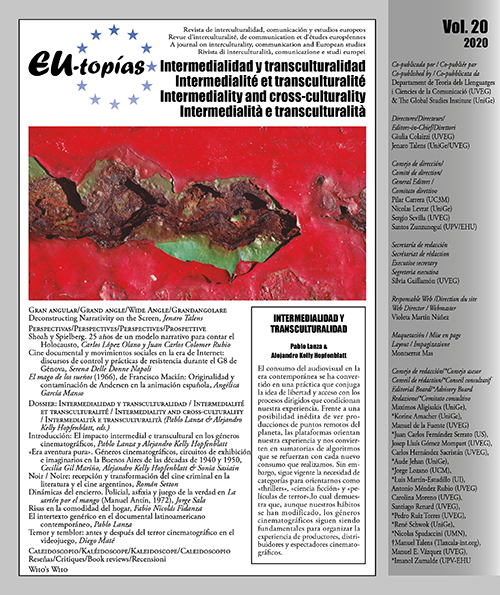Shoah and Spielberg. A Narrative Model to Tell the Holocaust, 25 Years Later
DOI:
https://doi.org/10.7203/eutopias.20.19386Keywords:
Holocaust, shoah, nazi, Schindler, memory, Spielberg. Abstract
Abstract
Schindler’s list represents a turning point in the narrative of the Holocaust. The film was well received by critics and the public, something unusual in Steven Spielberg’s career, as he was often considered as an author for children and good enough only as a filmmaker of adventures, yet not so much in Jewish intellectual circles. The negative critique to Spielberg’s cruel but hopeful fable was exercised especially by the director of another reference of the genre, formally situated at the opposite extreme: Claude Lanzmann, the director of the monumental Shoah. Now, a quarter of a century later, we analyze in this article what remains of the discussion and of Spielberg’s model of narration of what was one of the bleakest episodes of recent history: the nazi attempt of the Jews’ extermination.
 Downloads
Downloads
 References
References
Aizenberg, E. On the Edge of the Holocaust. Waltham, Massachusetts: Brandeis University Press, 2016.
Arendt, H. Eichmann in Jerusalem. A Report on the Banality of Evil. New York: Viking Press, 1963.
Arendt, H. Ensayos de comprensión 1930-1954: Escritos no reunidos e inéditos de Hannah Arendt. Madrid: Caparrós, 2005.
Bensoussan, G. Historia de la shoah. Barcelona: Anthropos, 2005.
Bracco, D. Bufonadas y monstruosidades: Una retórica del exceso en el cine cómico de Roberto Benigni. L’Atalante. Revista de estudios cinematográficos, 0 (27), 2019 Recuperado de http://links.uv.es/vM2i8Dk
Franklin, R. A thousand darknesses. Oxford [u.a.]: Oxford Univ. Press, 2011. Recuperado de http://links.uv.es/pUym7Me
Friedman, L. D. Citizen Spielberg. University of Illinois Press, 2006. Recuperado de http://links.uv.es/sP1H7vm
Gabarda, V. Els afusellaments al País Valencià (1938-1956). València: Publicacions de la Universitat de València, 2011.
Gourevitch, P. «A dissent on “Schindler’s list”». Commentary, 97, (49), 1994.
Hernández, C. Los campos de concentración de Franco. Barcelona: Ediciones B, 2019.
Hofmann, M. Historia de la literatura de la Shoah. Rubí, Barcelona: Anthropos Editorial, 2011.
Insdorf, A. Indelible Shadows. New York, NY: Vintage Books, 1983.
Keneally, T. Schindler’s Ark. London: Hodder Stoughton, 1982.
Lena Ordoñez, A. (2019). Víctimas y verdugos: La representación de Alemania en el cine clásico de Hollywood, 1942-1954. L’Atalante. Revista de estudios cinematográficos, 0 (27), 2019. Recuperado de http://links.uv.es/oHU0JQJ
Longerich, P. Holocaust: The Nazi Persecution and Murder of the Jews. Oxford; New York: Oxford University Press, 2010.
López-Olano, C. «Memoria y Universidad: una experiencia transmedia». En: Contenidos y formatos transmedia para la comunicación universitaria. (coord Miquel Francés y Guillermo Orozco Madrid: Síntesis (en prensa)
López-Olano, C. Guía para ver y analizar: En busca del arca perdida. Steven Spielberg (1981). Valencia: Nau Llibres, 2001.
Lozano Aguilar, A. (2015). Víctimas y verdugos en Shoah (Claude Lanzmann, 1985). Genealogía y análisis de un estado de la memoria del Holocausto. Tesis doctoral, 2015. Valencia: Universitat de València. Recuperado de http://links.uv.es/qx0L341
Marañón, Carlos. El hijo de Saúl (crítica). Cinemanía, (Enero), 2016. Recuperado de https://cinemania.20minutos.es/peliculas/el-hijo-de-saul/critica/
Mintz, A. L. (2001). Popular Culture and the Shaping of Holocaust Memory in America. Seattle: Univ. of Washington Press, 2001.
Palacio, J. M., & Ciller, M. C. «La mirada televisiva al pasado. el caso español (2005-2010)». En J. C. Ibánez, & F. Anania (Eds.), Memoria histórica e identidad en cine y televisión. Madrid: Contextos, 2001.
Picart, C. J., & Frank, D. A. Frames of Evil. Carbondale: Southern Illinois Univ. Press, 2006.
Rees, L. Auschwitz. Los nazis y la “Solución Final”. Barcelona: Crítica, 2005
— El oscuro carisma de Hitler. Barcelona: Crítica, 2017.
Sánchez Biosca, V. «Imágenes marcadas a fuego: Representación y memoria de la Shoah». Revista Brasileira de História, 21 (42), 2001, 283-302. doi: 10.1590/ S0102-01882001000300002
— Cine de historia, cine de memoria: La representación y sus límites. Madrid: Catedra, 2006.
— Miradas criminales, ojos de víctima. imágenes de la aflicción en Camboya. Buenos Aires: Prometeo, 2017.
Torner, C. Shoah: Cavar con la mirada. Barcelona: Gedisa, 2005.
Vice, S. Holocaust Fiction. London: Routledge, 2000.
Downloads
Published
How to Cite
-
Abstract365
-
PDF (Español)620
Issue
Section
License
![]()
The authors conserve the copyright. All content published in EU-topías. Journal of interculturality, Communication, and European Studies are subject to the license Creative Commons Attribution-NonCommercial-ShareAlike 4.0 license. The full text of the license can be found at <http://creativecommons.org/licenses/by-nc-sa/4.0>
They may be copied, used, disseminated, transmitted and publicly displayed, provided that:
- The authorship and original source of the publication is cited (journal, publisher and URL of the work).
- They are not used for commercial purposes.
- The existence and specifications of this license of use are mentioned.
It is the responsibility of the authors to obtain the necessary permissions for images that are subject to copyright.



